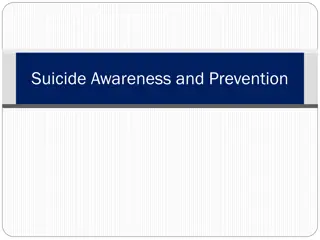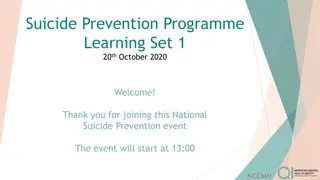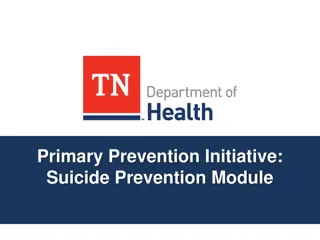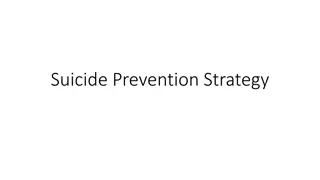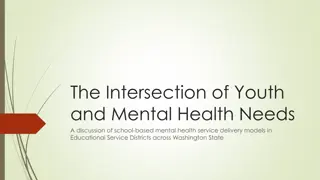Understanding Suicide Prevention and Awareness Training
This training program by the VA Office of Mental Health and Suicide Prevention (OMHSP) provides valuable insights on suicide prevention, including common myths and realities, identifying at-risk individuals, and steps to take. Learn about the scope of suicide in the U.S., how to recognize Veterans at risk, and what actions to take. Explore facts about suicide, the 2019 National Veteran Suicide Prevention Annual Report, data on suicide in the U.S., risk and protective factors, and resources for immediate help.
Download Presentation

Please find below an Image/Link to download the presentation.
The content on the website is provided AS IS for your information and personal use only. It may not be sold, licensed, or shared on other websites without obtaining consent from the author. Download presentation by click this link. If you encounter any issues during the download, it is possible that the publisher has removed the file from their server.
E N D
Presentation Transcript
S.A.V.E. Training VA Office of Mental Health and Suicide Prevention (OMHSP) Suicide Prevention Program
A Little Housekeeping Before We Start: Suicide is an intense topic for some people. If you need to take a break, or step out, please do so. Immediate Resources: National Suicide Prevention Lifeline: 1-800-273-8255 Service members and Veterans should press 1 to connect with the Veterans Crisis Line. St. Louis Herbert Lomax Jr. (Suicide Prevention Social Worker) (314)652-4100 ext. 64871 Herbert.LomaxJr@va.gov National Suicide Prevention Number 800-273-8255 2
Overview Objectives Facts about Suicide Common Myths vs. Realities The Steps of S.A.V.E. 3
Objectives By participating in this training, you will: Have a general understanding of the scope of suicide within the United States. Know how to identify a Veteran who may be at risk for suicide. Know what to do when you identify a Veteran at risk. 4
2019 National Veteran Suicide Prevention Annual Report Annual Report Reports on trends in Veteran suicide deaths from 2005 2017 Focuses on suicide counts and rates among various Veteran subpopulations State Data Sheets Examined state level Veteran suicide deaths and compared to national and regional trends 53 data sheets available for all 50 states, D.C., Puerto Rico, and U.S. Territories Access the reports online: https://www.mentalhealth.va.gov/mentalhealth/suicide_prevention/data.asp 6
Data: Suicide in the U.S. National public health problem (as defined by CDC) Over 45,000 Americans died by suicide in 2017, including 6,139 Veterans. Service member and Veteran issue In 2017, the suicide rate for Veterans was 1.5 times the rate for non-Veteran adults. Veteran populations at risk Younger Veterans Women Veterans Veterans in a period of transition Veterans with exposure to suicide Veterans with access to lethal means 7
Risk and Protective Factors Risk Prior suicide attempt Mental health issues Substance abuse Access to lethal means Recent loss Legal or financial challenges Relationship issues Unemployment Homelessness Protective Access to mental health care Sense of connectedness Problem-solving skills Sense of spirituality Mission or purpose Physical health Employment Social and emotional well-being Goal: Minimize risk factors and boost protective factors 8
Suicide Count, U.S. Adult and Veteran Populations (20052017) From 2005 to 2017, there was a 43.6% increase in the number of suicide deaths in the general population and a 6.1% increase in the number of suicide deaths in the Veteran population. 10
Veteran Suicide Deaths: Count vs. Rate Veteran Suicide Deaths in 2017 The absolute number of suicides was highest among Veterans ages 55 74. Veterans ages 18 34 had the highest suicide rate. 11
U.S. Veterans and Suicide Methods (2017) Female Veterans Male Veterans 4.8% 8.1% 15.6% 19.9% 43.2% 8.9% 70.7% 28.7% Firearm Injury Poisoning Firearm Injury Poisoning Suffocation Other Suffocation Other 12
Method of Suicide Among Veteran and Non-Veteran Adults Who Died by Suicide (2017) In 2017, 69.4% of Veteran suicide deaths were due to a self-inflicted firearm injury. 13
Time From Decision to Action < 1 Hour Source: Simon, T.R., Swann, A.C., Powell, K.E., Potter, L.B., Kresnow, M., and O Carroll, P.W. Characteristics of Impulsive Suicide Attempts and Attempters. SLTB. 2001; 32(supp):49-59. Source: CDC WISQARS and US Dept. of Veterans Affairs https://www.mirecc.va.gov/lethalmeanssafety/facts/ 14
Suicide is preventable. 15
Common Myths vs. Realities Myth Reality People who talk about suicide are just seeking attention. 17
Common Myths vs. Realities Myth Reality No matter how casually or jokingly said, suicide threats should never be ignored and may indicate serious suicidal feelings. Someone who talks about suicide provides others with an opportunity to intervene before suicidal behaviors occur. 18
Common Myths vs. Realities Myth Reality The only one who can really help someone who is suicidal is a mental health counselor or therapist. 19
Common Myths vs. Realities Myth Reality Special training is not required to safely raise the subject of suicide. Helping someone feel included and showing genuine, heartfelt support can also make a big difference during a challenging time. 20
S.A.V.E.: Teaching Communities How to Help Veterans at Risk for Suicide S.A.V.E. will help you act with care and compassion if you encounter a Veteran who is in suicidal crisis. Signs of suicidal thinking should be recognized. Ask the most important question of all. Validate the Veteran s experience. Encourage treatment and Expeditegetting help. 22
Signs of Suicidal Thinking Learn to recognize these warning signs: Hopelessness, feeling like there is no way out Anxiety, agitation, sleeplessness, or mood swings Feeling like there is no reason to live Rage or anger Engaging in risky activities without thinking Increasing alcohol or drug use Withdrawing from family and friends 23
Signs of Suicidal Thinking The presence of any of the following signs requires immediate attention: Thinking about hurting or killing themselves Looking for ways to die Talking about death, dying, or suicide Self-destructive or risk-taking behavior, especially when it involves alcohol, drugs, or weapons 24
Asking the Question Know how to ask the most important question of all Are you thinking about killing yourself? 25
Asking the Question Do s Don ts DO ask the question if you ve identified warning signs or symptoms. DON T ask the question as though you are looking for a no answer. You aren t thinking of killing yourself, are you? DO ask the question in a natural way that flows with the conversation. DON T wait to ask the question when someone is halfway out the door. 26
Validate the Veterans Experience Talk openly about suicide. Be willing to listen and allow the Veteran to express his or her feelings. Recognize that the situation is serious. Do not pass judgment. Reassure the Veteran that help is available. 27
Encourage Treatment and Expedite Getting Help What should I do if I think someone is suicidal? Don t keep the Veteran s suicidal behavior a secret. Do not leave him or her alone. Try to get the person to seek immediate help from his or her doctor or the nearest hospital emergency room. Call 911. Reassure the Veteran that help is available. Call the Veterans Crisis Line at 1-800-273-8255 and Press 1. 28
When Talking with a Veteran at Risk for Suicide Remain calm. Listen more than you speak. Maintain eye contact. Act with confidence. Do not argue. Use open body language. Limit questions let the Veteran do the talking. Use supportive, encouraging comments. Be honest let the Veteran know that there are no quick solutions, but help is available.
Remember S.A.V.E. S Signs of suicidal thinking should be recognized. A Ask the most important question of all. V Validate the Veteran s experience. E Encourage treatment and Expedite getting help.
Debrief Any other thoughts, feelings, questions? 31
STL Suicide Prevention Contact Information Suicide Prevention EMERGENCY Pager: 5 PAGE 9009 Suicide Prevention Team Phone: (314) 894-6166 Staff: Monday Friday from 0800-1600 Kristen Damian Herbert Lomax Jr. Michael Binetsch Evenings, Weekends, and Holidays: Emergency Dept: (314) 289-6410 or Contact VA Operator 314-652-4100 Press- 0 or Veterans Crisis Line (800) 273-8255 ext. 63103 ext. 64871 ext. 63091 32
My contact information Herbert Lomax Jr. Suicide Prevention Social Worker St. Louis VA Hospital (314)652-4100 ext. 64871 Email Contact Information Herbert.LomaxJr@va.gov 33




